Introduction
Temenos contract-based financial applications can generate SWIFT MT103/202 payment messages. Temenos strategic business modules generate Payment Orders and Temenos Payment solution decides the payment channel and the format of the messages that must be exchanged. Temenos legacy modules (for example, LD) which do not have the capability to generate payment orders will not be enhanced to provide this feature.
Temenos contract-based financial applications are designed to generate MT900/910 (debit and credit advice) messages. Some of these applications can also send MT210 (notice to receive) messages to their counterparties.
The Delivery MX Translation module enables banks to send ‘like for like’ (the tags populated in the ISO20022 outward messages are populated based on the fields supplied in the outward MT messages) ISO20022 CBPR compliant camt.054 and camt.057 messages to their counterparties based on the MT210/900/910 messages generated by the business modules. The Delivery MX Translation module also enables banks to generate Payment Order based on the MT103/202 messages generated by legacy modules like Loan and Deposit (LD) module.
Transact clients who are in releases prior to R22 AMR can implement a standalone Temenos Payments platform to process the ISO20022 SWIFT payments. Delivery MX Translation module, installed as part of standalone Temenos Payments platform, receives the MT103/202 generated by Transact business modules and transforms them to payment order. Temenos Payments executes the payment orders and generates the final ISO20022 message. Temenos Transact business modules that generate the MT210/900/910 messages can run in the same platform with Temenos Payments or can be implemented on a different platform (possibly on a lower release).
IZCAMT module is a Temenos strategic module that produces customer statements and account reporting messages. It offers ‘out of the box’ pre-configured enriched events and provides the flexibility to further customise and enrich the content of the transaction details. Delivery MX Translation module, available as part of Standalone Payments platform, generates ‘like for like’ ISO20022 statement and account report messages based on the MT940/950/941/942 messages generated from Temenos Transact.
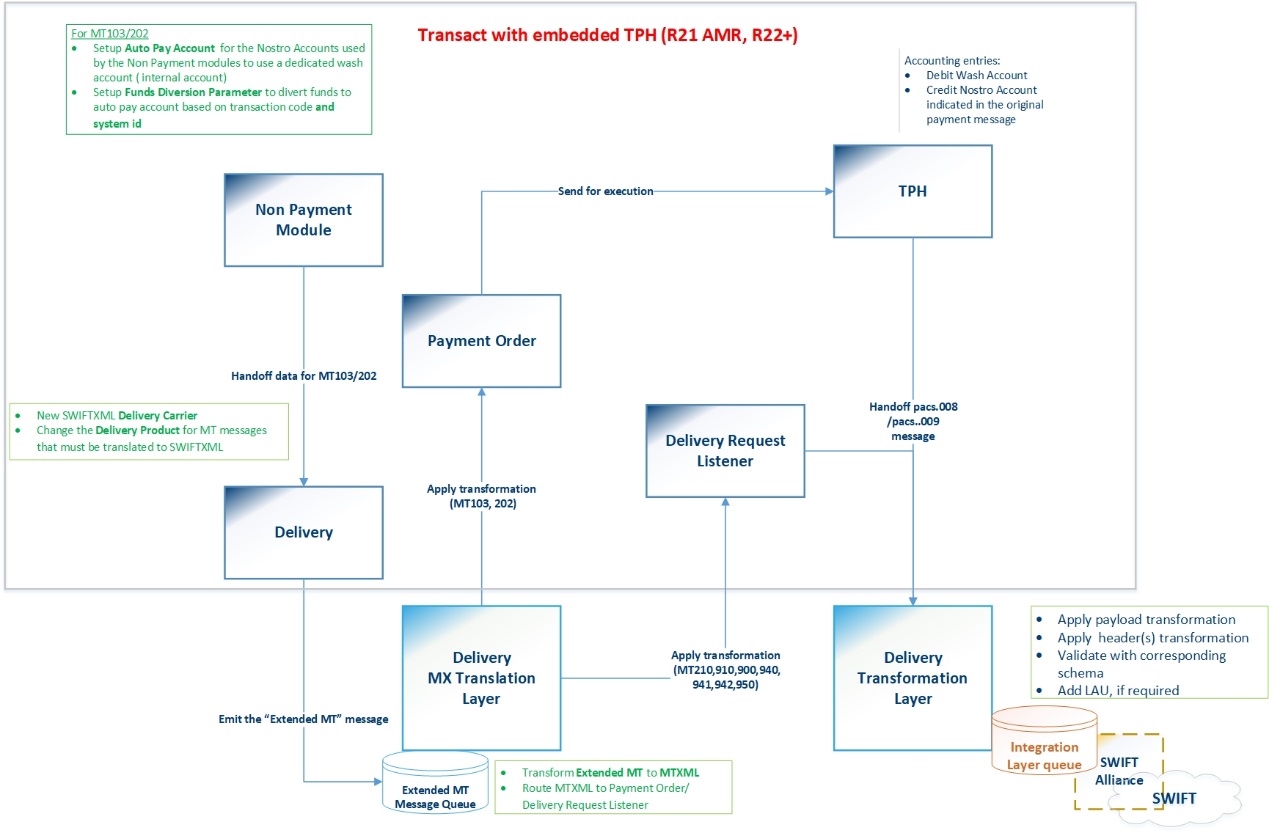
The SWIFTXML Delivery Carrier is released as part of Delivery (DE) module to be used for SWIFT MT messages that must be translated to ISO20022 standards. Though the SWIFTXML Delivery Carrier uses the SWIFT formatting module to generate MT messages, it has a dedicated interface which emits an extended MT message into a queue. The extended MT message includes the main details from the delivery message header along with the MT message.
Product Configuration
This section covers the setup required by the Delivery MX Translation module.
The Delivery module uses the SWIFT Delivery Carrier and SWIFT Formatting modules to generate MT messages. For the MT messages which must be translated to ISO20022, the bank must use a different Delivery Carrier. The SWIFTXML Delivery Carrier has been released for this purpose.
The setup of the SWIFTXML DE.CARRIER indicates:
- The Format Module is SWIFT.
- A dedicated
DE.INTERFACEis assigned to this Delivery Carrier (referred by the Interface field inDE.CARRIER) which emits messages through the Integration Framework and generates messages in the Temenos Extended MT format (the message includes the MT message along with the main details of the delivery header).
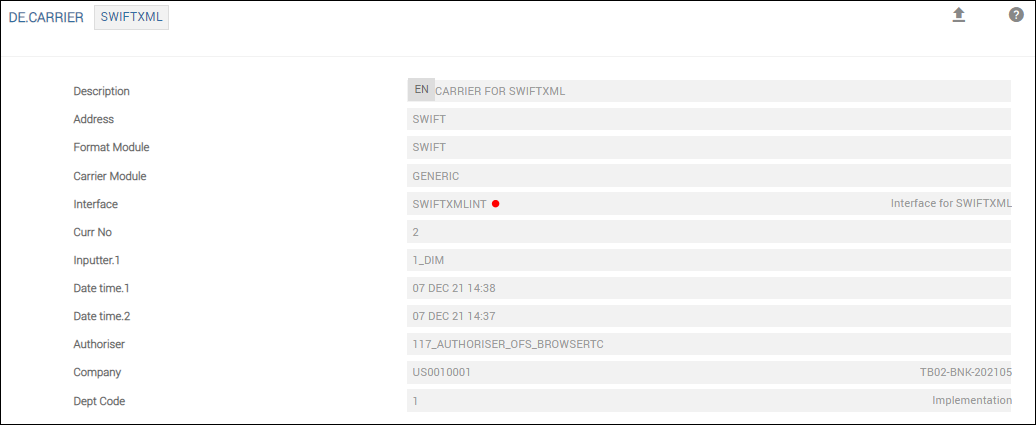
- The Ack Required field is set to No in the
DE.INTERFACEapplication.
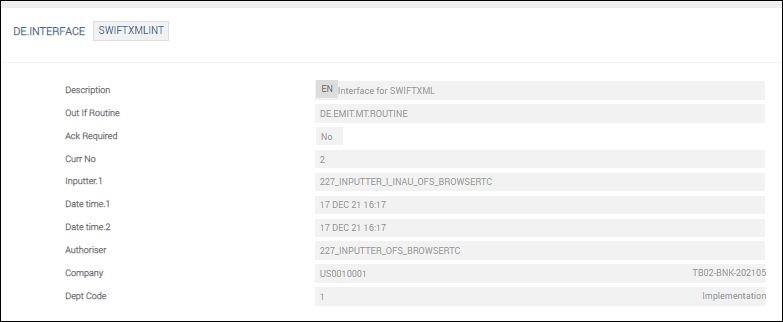
- The
DE.PRODUCTapplication decides the delivery preferences for the delivery messages. The default setup for the MT messages is to generate them using the SWIFT Delivery Carrier ( the Carrier Address No field inDE.PRODUCTis set to SWIFT.1). Implementations must change this setup to refer the SWIFTXML Delivery Carrier addresses when they want the MT messages to be translated to ISO20022 CBPR+ standards.
For each DE.CARRIER which has the Format Module field set to SWIFT, the bank must run its dedicated service – the naming convention is <<DE.CARRIER>.OUT.
TSA.SERVICE and its SWIFTXML.OUT BATCH on the platform where the business applications which are generating the MT messages are implemented. If Temenos Transact and TPH are running on different platforms, the records must be created in Temenos Transact.
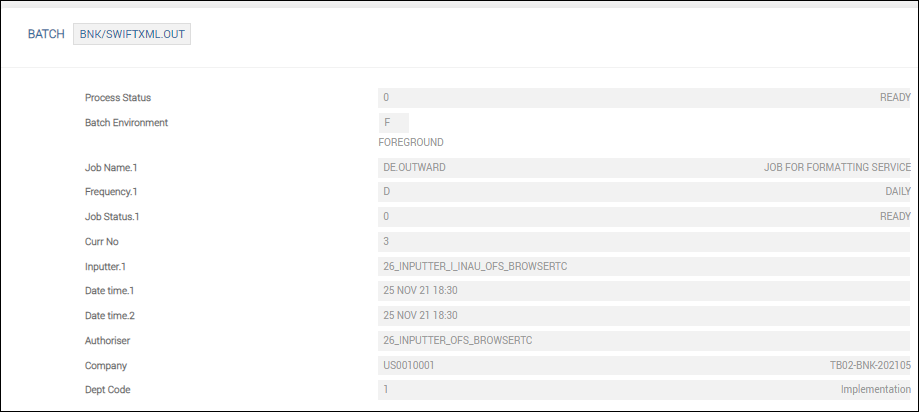
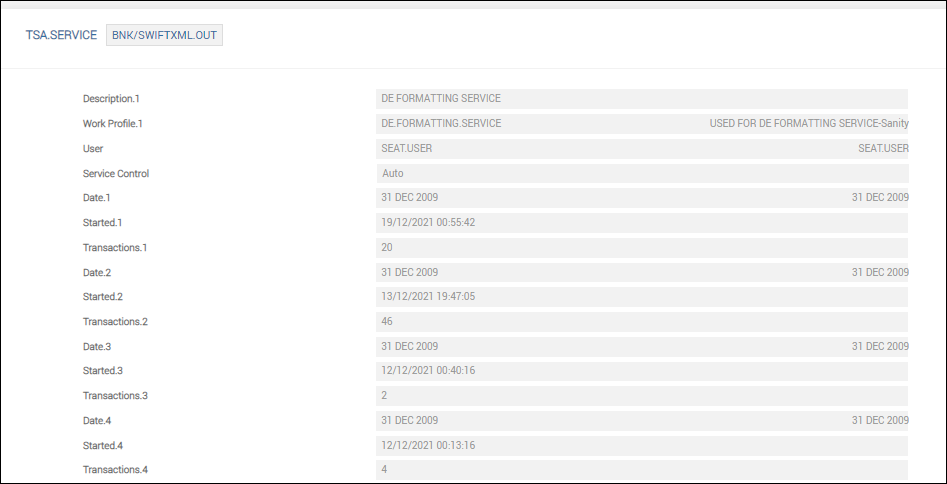
The bank must run the SWIFTXML.OUT and INTEGRATION.SERVICE services to generate the messages in the extended MT format.
The integration queue where the SWIFTXMLINT DE.INTERFACE emits the extended MT message to the Delivery Translation layer must be defined in the IF.INTEGRATION.SERVICE.PARAM application:
- Event type destination: Outwardmessageservice-mtmessageflow
- Event destination: queue/t24MtMessageQueue
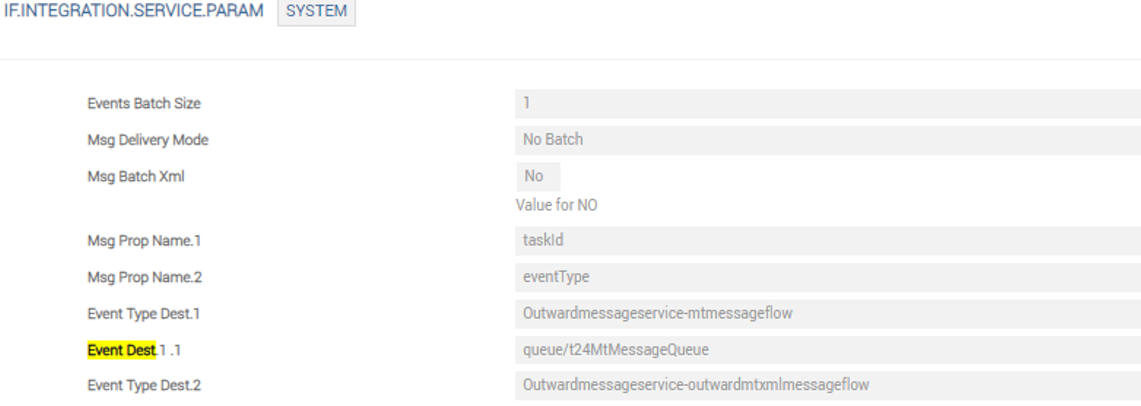
The name of the Delivery MX Translation component is DEMXTR_MTMXOutward-0.0.1-SNAPSHOT.war, which must be deployed in the Temenos\jboss\standalone\deployments path. The technical characteristics for the Delivery MX Translation processing are defined in the DEMXTR_MTMXOutward property file. For example, the queue mechanism connectivity, ip, max connections and number of concurrent consumers.
The Delivery MX Translation layer processes the extended MT messages based on the setup in the DEMXTR_MTMXOutward_QueueConfig property file. The file describes the various queues through which the messages are moved during processing and the routing rules based on which the Delivery MX Translation layer determines the processing rule and the processing characteristics.
The configurations defined in this file are described below:
- RouteChannel attribute – Indicates the internal processing of the message is done using queues (ActiveMq) or folders. The values are ACTIVEMQ or FILESYSTEM; however, FILESYSTEM is used for Temenos internal purposes.
- DEMXTRHandoffQueue attribute – Defines the queue where the MT messages generated by the business applications are emitted through the Delivery module in the extended MT format. Delivery MX Translation picks the messages from this queue and starts the processing, applying the DEMXTR-MTXML.xslt to transform the message into MTXML format.
- MtXmlTransPostQueue attribute – Indicates the queue where DEMXTR places the message if the transformation into MTXML format is successful. This message is evaluated using the routing rules to decide the target processing.
- transformationFailQueue attribute – Indicates the queue where DEMXTR places the message in the Extended MT format, if the transformation to MTXML format fails.
- DefaultQueue attribute – Indicates the queue where DEMXTR places the MTXML format, if no routing rule is matched and no processing rule is found.
- T24DeliveryQueue attribute – Identifies the queue where DEMXTR sends the messages to the target application in the target application format (the Delivery Request Listener application installed on the same platform with TPH). The messages are processed using XMLOFS OFS.SOURCE.
- extTransFailQueue attribute – Specifies the queue where DEMXTR places the message if transformation to the target application format fails. The message is in MTXML format.
- DLQError attribute – Specifies the folder where DEMXTR places the message if the queues become unavailable during processing.
The routing rules which are used to determine the processing rules are defined in the following manner:
MessageType-ServiceIdentifier-Application-SenderBic-SourceCarrier=Channel
The ‘*’ can be used as a wildcard character to indicate any value. For example, considering the following setup:
- 900-*-*-*-SWIFTXML=ROUTECBPR
- 910-*-*-*-SWIFTXML=ROUTECBPR
- 210-*-*-*-SWIFTXML=ROUTECBPR
- 103-*-*-*-*=103ROUTE
- 202-*-*-*-*=202ROUTE
According to this setup, the MT210, 900, 910 messages are processed based on the characteristics defined for the ROUTECBPR channel, irrespective of the service identifier, application generating them, sender BIC or source carrier.
The processing characteristics for the target channel are defined as <Channel>>-attributeName. The following attributes are supported:
- SystemId attribute — Identifies the target module to which the message is routed.
- Carrier attribute — Specifies the carrier which is to be used if the message is sent to the Delivery module.
- Xslt attribute — Specifies the name of the XSLT that is applied to the MTXML message before sending the message to the target module.
- Company attribute — Specifies the company to which the message is re-routed (in an implementation which involves Temenos Transact and standalone TPH, the companies in Temenos Transact could be different from those defined in Standalone TPH). If this is blank, the target company for the ISO20022 message is the same as the source company of the MT message.
- POProduct — Used for MT103/202 routing and indicates the Payment Order product.
For example, the following setup indicates the processing attributes for the ROUTECBRP channel:
- ROUTECBPR-SystemId=DE
- ROUTECBPR-Carrier=CBPRPLUS
- ROUTECBPR-Xslt=transformToDeliveryRequest.xslt
- ROUTECBPR-Company=
According to this setup, the Delivery MX Translation module applies the transformToDeliveryRequest.xslt transformation to the MTXML message processed through the ROUTECBPR channel, set the target Delivery Carrier to CBPRPLUS and then routes the message to the Delivery module (identified by SystemId attribute).
- The target company where the MTXML message is processed is the same as company for the source MT message (Company is blank).
- The properties file can be amended to suit the implementations. However, the attributes must not be removed. The implementation can remove the value defined for the respective attribute rather than remove or comment the attribute itself.
Illustrating Model Parameters
Model Parameters are not applicable for this module.
Illustrating Model Products
The SWIFTXML DE.CARRIER and SWIFTXMLINT DE.INTERFACE have been released to generate the MT messages that must be translated into ISO20022.
In this topic